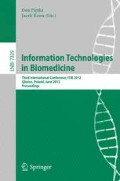Abstract
Human-computer interaction (HCI) is an emerging field of science aimed at providing natural ways for humans to use computers. There are various approaches to build mouse alternatives. Unfortunatelly, many existing solutions are not designed for people with severe physical disabilities.
The work presented here is part of the larger project and focusses on facial action recognition framework and its components. It uses only optical observation - camera and image analysis and recognition algorithms. Proposed system gives possibility to serve the special needs of people with various disabilities, especially to use computers and possibly other devices. Consequently, in our opinion, it can offer disabled people access to a wide range of services which help them to participate more fully in society.
Access this chapter
Tax calculation will be finalised at checkout
Purchases are for personal use only
Preview
Unable to display preview. Download preview PDF.
References
Augustyniak, P., Tadeusiewicz, R.: Complete Scanpaths Analysis Toolbox. In: Conf. Proc. IEEE Eng. Med. Biol. Soc., vol. 1 (2006)
Betke, M., Gips, J., Fleming, P.: The camera mouse, Visual tracking of body features to provide computer access for people with severe disabilities. IEEE Trans. on Neural Systems and Rehabilitation Eng. 10(1), 1–10 (2002)
Bobick, A.F., Davis, J.W.: Action Recognition Using Temporal Templates. In: CVPR 1997, pp. 125–146 (1997)
Bradski, G.R.: Computer Vision Face Tracking For Use in a Perceptual User Interface. Intel Technology Journal Q2 (1998)
Broniec, A.: Motion and motion intention representation in eeg signal and possibilities of application in man machine interface. Master’s thesis. AGH University of Science and Technology, Krakow (2007)
Evans, D.G., Drew, R., Blenkhorn, P.: Controlling mouse pointer position using an infrared head-operated joystick. Proc. IEEE Trans. 8(1), 107–117 (2000)
Gong, S., McKenna, S.J., Psarrou, A.: Dynamic Vision, From Images to Face Recognition. Imperial College Press, London (2000)
Grossberg, S.: How Does The Cerebral Cortex Work? Learning Attention, and Grouping by the Laminar Circuits of Visual Cortex (1999)
Hjelmas, E., Low, B.K.: Face detection. A Survey: Computer Vision and Image Understanding, 236–274 (2001)
Hsu, R.-L., Abdel-Mottaleb, M., Jain, A.K.: Face detection in color images. IEEE Trans. Pattern Anal. Mach. Intell. 24(5), 696–706 (2002)
Isard, M., Blake, A.: CONDENSATION - conditional density propagation for visual tracking. Int. J. Computer Vision 29(1), 5–28 (1998)
Keselman, Y., Dickinson, S.: Bridging the Representation Gap Between Models and Exemplars. In: Proc. IEEE Computer Society Workshop on Models versus Exemplars in Computer Vision (2001)
Lindeberg, T.: Scale-space theory, A basic tool for analysing structures at different scales. J. of Applied Statistics 21(2), 224–270 (1994)
Ober, J., Hajda, J., Loska, J.: Applications of eye movement measuring system ober2 to medicine and technology. In: Proceedings of SPIE (1997), doi:10.1117/12.280352
Oviatt, S.: Multimodal interfaces. In: Jacko, J., Sears, A. (eds.) Handbook of Human-Computer Interaction, Mahwah NJ Lawrence Erlbaum (2002)
Przybylo, J.: Eye and nostril localization for automatic calibration of facial action recognition system. Computer Recognition Systems 3 57, 53–61 (2009)
Yilmaz, A., Javedb, O., Shah, M.: Object tracking. A Survey ACM Comput. Surv. 38(4), 13 (2006), doi:10.1145/1177352.1177355
Author information
Authors and Affiliations
Editor information
Editors and Affiliations
Rights and permissions
Copyright information
© 2012 Springer-Verlag Berlin Heidelberg
About this paper
Cite this paper
Przybyło, J. (2012). Vision Based Facial Action Recognition System for People with Disabilities. In: Piętka, E., Kawa, J. (eds) Information Technologies in Biomedicine. Lecture Notes in Computer Science(), vol 7339. Springer, Berlin, Heidelberg. https://doi.org/10.1007/978-3-642-31196-3_58
Download citation
DOI: https://doi.org/10.1007/978-3-642-31196-3_58
Publisher Name: Springer, Berlin, Heidelberg
Print ISBN: 978-3-642-31195-6
Online ISBN: 978-3-642-31196-3
eBook Packages: Computer ScienceComputer Science (R0)

